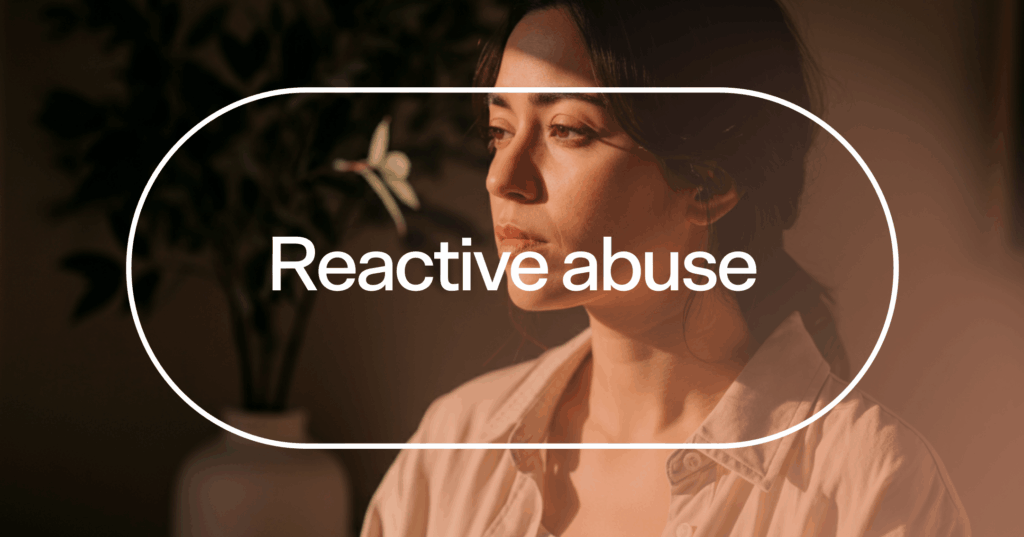Reactive abuse happens when you’re pushed to your breaking point and respond in a big or emotional way. It doesn’t mean you’re the one causing harm.
The person causing harm may use your reaction to shift blame or make you feel like you’re at fault.
Recognizing this pattern can help you understand what’s happening and take steps toward healing and safety.
Reactive abuse happens when someone who’s being hurt or manipulated reacts in a big or emotional way — like yelling, throwing something, or saying something harsh. After this reaction, the person causing harm may point to that outburst and say you’re the abusive one. This can be very confusing, especially if you were trying to defend yourself.
Some people debate the term “reactive abuse” because it can make the survivor feel like they did something wrong. But your reaction doesn’t make you the abuser. Rather, it means you were pushed to your limit in an attempt to protect yourself. It’s important to look at the full picture: who holds power in the relationship, who starts the harm, and whether the behavior is part of a pattern. Naming this experience can help you make sense of what happened and take steps toward healing.
A note to the reader: If you feel unsafe in your relationship for any reason, contact the National Domestic Violence Hotline by dialing 800-799-7233 for confidential support.
What reactive abuse looks like
Reactive abuse is a strong emotional reaction to abuse. You might yell, say something harsh, or even physically react — all in response to the harm being done to you. These reactions happen when you’re pushed to your limit and trying to protect yourself.
Signs that someone’s behavior is a reaction to abuse include:
Verbal outbursts: Yelling or saying hurtful things when you feel trapped or threatened
Physical reactions: Throwing something or, in more extreme cases, hitting or pushing
Emotional responses: Crying, withdrawing, or feeling overwhelmed by the constant stress of the situation
These reactions are often misunderstood. Instead of seeing it as self-defense, the person who’s causing harm may focus on your reaction and accuse you of being the abuser. This is common in emotionally abusive relationships, in which the focus shifts from the abuser’s harmful actions to your emotional responses.
Dig deeper:
Reactive abuse and gaslighting
Gaslighting is a form of manipulation in which someone makes you doubt your reality. When you’re experiencing reactive abuse, the abuser may use gaslighting to twist the situation. They may try to make you believe that you’re the one causing harm or that your reaction was unprovoked. This can leave you feeling confused and questioning yourself, even when you’re simply reacting to the harm they’ve caused.
Self-defense vs. reactive abuse
It’s important to understand the difference between self-defense and reactive abuse. Self-defense is when you take action to protect yourself from harm. It’s your natural response to being threatened. Reactive abuse, on the other hand, happens when your emotions boil over after continuous abuse, and it may involve lashing out or reacting strongly.
The key difference is that self-defense is about protecting yourself, while reactive abuse is often a response to prolonged abuse that results in an emotional or physical outburst. Neither should be seen as abuse but, rather, a reaction to the real harm being caused.
The care you need, when you need it
Learn how Rula can support your mental health journey
Understanding reactive responses to abuse
Reactive abuse doesn’t mean you’re the abusive one. It means you were pushed to your limit. When someone uses emotional, verbal, or physical tactics to wear you down, your body can go into survival mode. You might yell, cry, or lash out as a way to protect yourself. If you’ve experienced trauma or grew up in a high-conflict environment, your reactions may feel especially intense.
Some people use subtle manipulation — like gaslighting, guilt tripping, or unpredictable moods — to stay in control. Over time, these behaviors can wear you down and leave you questioning your own reality. While some mental health conditions — like narcissistic personality disorder (NPD), borderline personality disorder (BPD), or substance use disorders — may play a role in harmful dynamics.
For example, someone struggling with intense emotional swings might lash out during a conflict, or someone avoiding shame may deflect blame onto others. But even when mental health is part of the picture, it’s not an excuse for mistreatment. You didn’t cause someone else’s behavior, and your reaction doesn’t make you the abusive one.
What is the “reactive abuse cycle?”
The reactive abuse cycle often follows a predictable pattern:
You’re provoked. The other person criticizes, manipulates, or pushes your boundaries repeatedly.
You react. You raise your voice, shut down, or do something out of character to protect yourself.
They blame you. The other person points to your reaction and calls you the problem.
You feel confused and ashamed. You wonder if you’re abusive or if you deserve the treatment you’ve been getting.
The cycle starts again. And because your response is used against you, it can feel harder to trust your own instincts or break free.
This pattern can keep you feeling stuck and off balance. Learning to recognize and name it is a powerful first step in breaking free.
How to deal with reactive abuse
If you’ve been caught in a cycle of reactive abuse, you’re not alone — and it’s not your fault. When someone constantly pushes your buttons, it’s natural to react. But if those reactions are being used against you, it can leave you feeling confused, ashamed, or stuck. The good news is that you can take steps to protect your peace and break the cycle.
Here are some practical steps to support you in ending the cycle of reactive abuse:
Create emotional space. When you’re being provoked, it’s natural to want to react right away. But if you can pause — even briefly — it gives you time to notice what’s happening and make a choice that can keep you safe. Try stepping away, taking deep breaths, or saying, “I need a moment,” if you feel yourself getting overwhelmed.
Strengthen your support system. Having people who believe you and validate your experience makes a big difference. Talk to a trusted friend, family member, or therapist. Or consider joining a support group. You deserve relationships where you feel safe, heard, and respected.
Practice coping skills that help you feel steady. You can’t control how someone else acts, but you can learn tools to stay centered. Grounding exercises or journaling can help you stay calm. The goal is not to shut down your emotions — it’s to care for them gently.
Remind yourself of the difference between defense and abuse. If you yell, cry, or push back in a heated moment, that doesn’t make you the abuser. Abuse is about power and control over time. Defending yourself — especially when you feel threatened — is a survival response, not a pattern of harm.
Reach out to a trauma-informed therapist. A good therapist can help you make sense of your experience, rebuild your confidence, and give you tools to cope. Therapies like cognitive behavioral therapy (CBT), dialectical behavior therapy (DBT), acceptance and commitment therapy (ACT), and eye movement desensitization and reprocessing (EMDR) can be especially helpful if you’ve been stuck in survival mode or second-guessing yourself.
Make a safety plan if the relationship feels unsafe. If someone is repeatedly harming or manipulating you, it’s OK to think about what it would take to leave. You don’t have to do it alone. Hotlines, shelters, and mental health professionals can help you build a step-by-step plan. You deserve to be safe — physically, emotionally, and mentally.
It can be incredibly hard to recognize reactive abuse while you're still in it because the dynamic is confusing by design. Over time, you may start to believe your natural responses — like crying, yelling, or shutting down — are the real problem, especially if the other person uses them against you. You're not alone, and working with a therapist can help you make sense of what's happening and start to heal.

Brandy Chalmers, LPC
Clinical reviewer
Find care with Rula
Reactive abuse happens when someone reacts strongly to ongoing harm, leading to confusion and self-blame. It’s important to know that these reactions are a result of being pushed too far, not because you did something wrong. Understanding this cycle can help you break free and heal. With the right support, you can regain your confidence and move toward a safer, healthier future.
At Rula, we’re committed to delivering a comprehensive behavioral health experience that helps people feel seen and understood so they can get back to feeling their best.
Rula makes it easier to find a licensed therapist or psychiatric provider who accepts your insurance so you don’t have to choose between affordable care and excellent care. With a diverse network of more than 15,000 providers, 24/7 crisis support, and appointments available as soon as tomorrow, we’re here to help you make progress — wherever you are on your mental health journey.
Rula's editorial process
Rula's editorial team is on a mission to make science-backed mental health insights accessible and practical for every person seeking to better understand or improve mental wellness.
Members of Rula’s clinical leadership team and other expert providers contribute to all published content, offering guidance on themes and insights based on their firsthand experience in the field. Every piece of content is thoroughly reviewed by a clinician before publishing.



